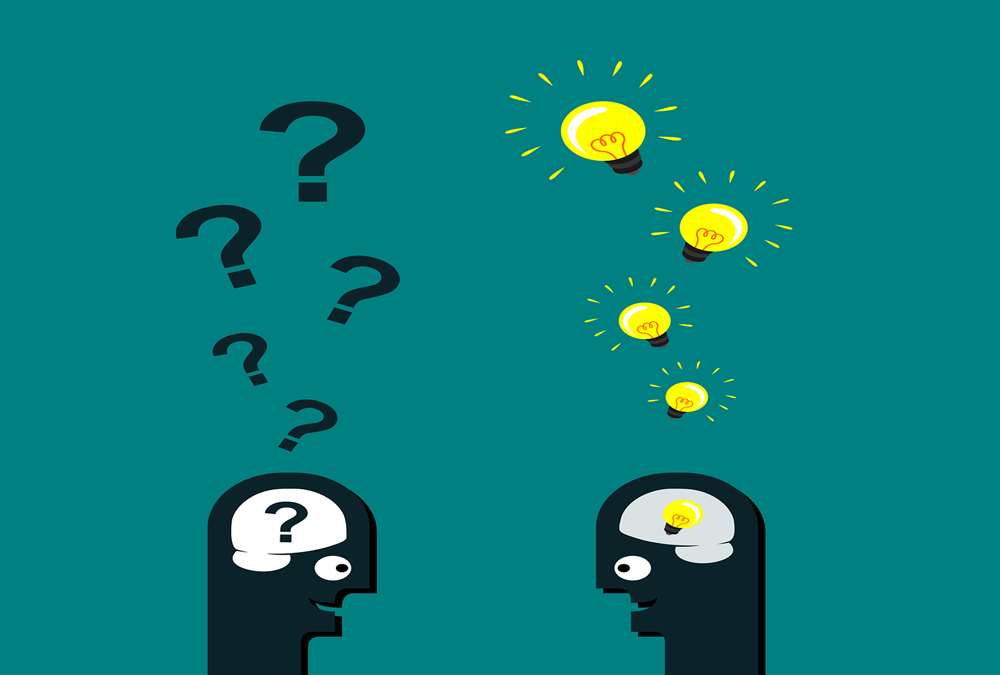- Home
- Business Processes
- Industry Knowledge
- Aerospace Industry
- Automotive Industry
- Banking Domain
- BFSI Industry
- Consumer/ FMCG Industry
- Chemicals Industry
- Engineering & Construction
- Energy Industry
- Education Domain
- Finance Domain
- Hospitality Domain
- Healthcare Industry
- Insurance Domain
- Retail Industry
- Travel and Tourism Domain
- Telecom Industry
- Leadership Skills
- eLearning
- Home
- Leadership Skills
- Decision Making
- Generating Ideas using Brainstorming
Generating Ideas using Brainstorming
The brainstorming technique was developed by Alex F. Osborn in 1957 and brainstorming means where a team of members generates a large amount of alternative fruitful ideas on a specific problem without any criticism and then evaluates each idea in terms of their pros and cons. Brainstorming techniques fall into four broad categories: visioning, exploring, modifying, and experimenting.
Creativity involves breaking out of established patterns in order to look at things in a different way - Edward de Bono
Origin of Brainstorming
Alex F. Osborn an advertising executive began developing methods for creative problem-solving in 1939. He began hosting group-thinking sessions and discovered a significant improvement in the quality and quantity of ideas produced by employees He first called these sessions as ‘organized ideation’ which was later dubbed by participants as "brainstorm sessions". Osborn recommended that all members of the group should be provided with a clear problem statement to be addressed and the problem should be simple and targeted.
Meaning of Brainstorming
Brainstorming means where a team of members generates a large amount of alternative fruitful ideas on a specific problem without any criticism and then evaluates each idea in terms of their pros and cons.
- The purpose behind this group's creative technique is to provide other information as input for further stimulation.
- A comprehensive checklist is then made to eliminate the ideas that are clearly unworkable while retaining those that are worth further consideration.
- A particularly useful tool for stimulating divergent thought is brainstorming.
- Brainstorming builds fluency and flexibility. Enhances the group’s ability to produce many original ideas easily and also to come up with many different kinds of ideas
Principles of Brainstorming Sessions
For a brainstorming exercise to succeed, it's crucial to observe four key principles:
- Focus the brainstorming on an actual problem that your group is trying to solve.
- In other words, your brainstorming should be bound by real-world constraints.
- Limit the discussion to one conversation at a time and keep it focused on the topic.
- Participants are encouraged to provide wild and unexpected answers because the quantity of ideas affects the quality of the final decision.
- Ideas receive no criticism or discussion.
- Try to build on the ideas of others whenever possible.
- Ask questions that haven't been asked before
- Ask questions from different perspectives
- The group simply provides ideas that might lead to a solution
- During the session apply no analytical judgment as to the feasibility.
- Judgment should be suspended while ideas are being generated.
Four brainstorming techniques
Brainstorming techniques fall into four broad categories: visioning, exploring, modifying, and experimenting. Each category uses a different thought process, but there are some commonalities. Modifying and experimenting techniques, for example, start with existing data and use intuition to draw ideas from those facts. With visioning and exploring techniques, the intuitive process is followed by information gathering and data analysis.
1. Visioning
In this approach, the group tends to imagine a long-term, ideal solution and means of achieving it. The group starts by ignoring constraints of cost, time, and resources and try to produce the ideas for an ideal future. It has been observed that a breakthrough idea often comes from a seemingly irrelevant place. Once multiple ideas are generated team will start discussing the action plan to implement these ideas.
2. Exploring
In this approach, the group often uses guided imagery like symbols, analogies, and metaphors to describe an ideal scenario as well as to challenge assumptions. A variation of this method is to take the assumptions on the table and literally reverse them. A related approach called paradoxical thinking also helps free your mind from conventional patterns by developing an awareness of opposites.
3. Modifying
In this approach, the focus is to adapt to the current status quo. Modifying techniques begin with the status quo (like current technology or business situation or product or service) and tries to make adaptations to the current state. Exploring additional features or functionality the customers would you like to be included in the program or service.
4. Experimenting
The last approach is to experiment by methodically combining elements in various ways and then test the new arising combinations.
Evaluation of Ideas Generated During the Session
Each idea is to be considered in the light of the points like
- Does it meet the objectives?
- Does it solve the problems?
- Does it introduce new problems?
- Will it fit in with current systems?
- What functions are essential from your customers' point of view
- What criteria are determined by the company's values?
- What are your cost constraints?
- What are your size or shape constraints (for a product)?
- Within what time must you complete the project?
- Thinking cross-functionally/ organizationally
- In what ways the product is compatible with existing products?
- Taking risks and balancing day-to-day versus longer-term risks
- Can it accommodate growth?
Related Links
You May Also Like
-
Benefits of Teams in Workplace
The use of formal work teams is commonplace in modern organizations. But why we have teams? What are the benefits or advantages that teams provide for organizations and employees? Do we really need to adopt formal team structures and use team-building approaches in organizations? Read this article to explore and learn the benefits of having formal teams in organizations.
-
In its simplest sense, decision-making is the act of choosing between two or more courses of action. Decision making is a key skill in the workplace and is particularly important if you want to be an effective leader. When decisions have to be made, there are several stages that you should go through to reach a practical solution. Understand the meaning and importance of decision making and how to look at it as a process.
-
Building Perfect Creative Team
One misconception around creativity is that creative act is essentially solitary. Most of the world's important inventions resulted not from the work of one lone genius, but from collaboration of a team with complementary skills. Managers should build teams with the ideal mix of traits to form a creative group and then establish the conditions that make creativity much more likely to occur.
-
Stress is a product of the busyness of modern life. It has assumed grave dimensions ever since the emergence of industrialism. In fact, stress is a natural, ongoing, dynamic, and interactive process that takes place as people adjust to their environment. Stress can be brought about by positive or negative life events. Distress can cause disease and eustress or positive stress can promote wellbeing and increased productivity. Learn to recognize and be responsible for your stress, and learn the ways to manage stress.
-
Understanding Concept of Creativity
Part of your job as a manager is to foster new ideas. But how do you assemble a team with the right mix of skills and perspectives to promote creativity? Creativity is the ability to come up with new and different ideas or breakthrough fixed ways of thinking. Learn how to manage an intellectually diverse work group and their environment to produce more and better ideas that encourage innovation when developing products and work processes.
-
Collaborative leadership is all about collaborative problem-solving and decision-making or can also be defined as the leadership of a collaborative effort. . The term started to appear in the mid-1990s in response to the formation of long term public-private partnerships to rebuild public infrastructure. Learn how you can use principles of collaborative leadership to enhance your leadership skills for being an effective leader.
-
Generating Ideas using Brainstorming
The brainstorming technique was developed by Alex F. Osborn in 1957 and brainstorming means where a team of members generates a large amount of alternative fruitful ideas on a specific problem without any criticism and then evaluates each idea in terms of their pros and cons. Brainstorming techniques fall into four broad categories: visioning, exploring, modifying, and experimenting.
-
At different points in your professional career, it is helpful to identify your core values. Values are the qualities considered to be the most important guiding principles that determine the priorities in your life and greatly influence your career choices. Your career brings happiness when it is in agreement with the beliefs you have about what is important and meaningful to you. Awareness of your values will help you develop a clearer sense of what's most important to you in life.
-
Understanding Corporate Strategy
Management outlook and procedures have been revolutionized by more and more innovations over the recent years. It is no longer possible to follow traditional approaches to develop your organization's direction, its management as well its effectiveness. Senior managers need to be good decision-makers. In this section, we introduce concepts for strategy, strategic planning, strategic leadership, their exact meaning and associated terms, and how to use them.
-
Generating Ideas using SCAMPER
SCAMPER is an activity-based thinking process that can be performed by Cooperative learning. SCAMPER is an acronym that provides a structured way of assisting students to think out of the box and enhance their knowledge. This can be used in the organizational context as a technique for creative problem solving and as a toolkit to generate fresh ideas.
Explore Our Free Training Articles or
Sign Up to Start With Our eLearning Courses

About Us
Learning
© 2023 TechnoFunc, All Rights Reserved










